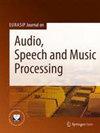在音频增强现实环境中盲目渲染虚拟声源的端到端方法
IF 1.9
3区 计算机科学
Q2 ACOUSTICS
Eurasip Journal on Audio Speech and Music Processing
Pub Date : 2024-03-27
DOI:10.1186/s13636-024-00338-6
引用次数: 0
摘要
音频增强现实(AAR)是音频领域的一个重要课题,它要求了解用户的听觉环境,以呈现真实的虚拟听觉对象。混响时间($RT_{60}$$)是表征房间声学特性的主要指标,已有许多方法被提出,用于从混响语音信号中盲目估算混响时间。然而,单一的 $$RT_{60}$ 值可能不足以正确描述和呈现房间的声学效果。本文介绍了一种估算多个房间声学参数的方法,这些参数是在未知环境中呈现接近准确的房间声学效果所必需的。文中展示了如何使用可部署在移动设备上的音频变压器盲法估算这些参数。此外,论文还讨论了如何利用估算出的房间声学参数,从真实 BRIR 数据集中找到类似的房间,并进一步用于渲染虚拟音源。此外,还提出了一种新颖的双耳房间脉冲响应(BRIR)增强技术,以克服数据不足的限制。最后,通过听力测试对所提出的方法进行了感知验证。本文章由计算机程序翻译,如有差异,请以英文原文为准。
An end-to-end approach for blindly rendering a virtual sound source in an audio augmented reality environment
Audio augmented reality (AAR), a prominent topic in the field of audio, requires understanding the listening environment of the user for rendering an authentic virtual auditory object. Reverberation time ( $$RT_{60}$$ ) is a predominant metric for the characterization of room acoustics and numerous approaches have been proposed to estimate it blindly from a reverberant speech signal. However, a single $$RT_{60}$$ value may not be sufficient to correctly describe and render the acoustics of a room. This contribution presents a method for the estimation of multiple room acoustic parameters required to render close-to-accurate room acoustics in an unknown environment. It is shown how these parameters can be estimated blindly using an audio transformer that can be deployed on a mobile device. Furthermore, the paper also discusses the use of the estimated room acoustic parameters to find a similar room from a dataset of real BRIRs that can be further used for rendering the virtual audio source. Additionally, a novel binaural room impulse response (BRIR) augmentation technique to overcome the limitation of inadequate data is proposed. Finally, the proposed method is validated perceptually by means of a listening test.
求助全文
通过发布文献求助,成功后即可免费获取论文全文。
去求助
来源期刊

Eurasip Journal on Audio Speech and Music Processing
ACOUSTICS-ENGINEERING, ELECTRICAL & ELECTRONIC
CiteScore
4.10
自引率
4.20%
发文量
0
审稿时长
12 months
期刊介绍:
The aim of “EURASIP Journal on Audio, Speech, and Music Processing” is to bring together researchers, scientists and engineers working on the theory and applications of the processing of various audio signals, with a specific focus on speech and music. EURASIP Journal on Audio, Speech, and Music Processing will be an interdisciplinary journal for the dissemination of all basic and applied aspects of speech communication and audio processes.
 求助内容:
求助内容: 应助结果提醒方式:
应助结果提醒方式:


